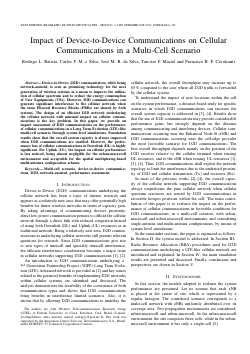
Impact of Device-to-Device Communications on Cellular Communications in a Multi-Cell Scenario
Rodrigo L. Batista, Carlos F. M. e Silva, José M. B. da Silva, Tarcisio F. Maciel, Francisco R. P. Cavalcanti
DOI: 10.14209/sbrt.2013.184
Evento: XXXI Simpósio Brasileiro de Telecomunicações (SBrT2013)
Keywords: Multi-cell scenario device-to-device communications D2D network-assisted performance assessment
Abstract
Device-to-Device (D2D) communication, while being network-assisted, is seen as promising technology for the next generation of wireless systems as a mean to improve the utilization of cellular spectrum and to reduce the energy consumption of User Equipments (UEs). However, D2D communications can generate significant interference to the cellular network when the same Physical Resource Blocks (PRBs) are shared by both systems. The design of an efficient D2D network underlaying the cellular network with minimal impact on cellular communications is the key problem. In this paper, we provide an impact assessment of D2D communications on the performance of cellular communications in a Long Term Evolution (LTE)-like multi-cell scenario through system-level simulations. Simulation results show that the overall system capacity is always improved when D2D communications are enabled. However, the performance loss of cellular communications in Downlink (DL) is highly significant. For Uplink (UL), the impact on cellular performance is less noticed, being almost negligible for the urban-macrocell environment and acceptable for the spatial multiplexing-based multi-antenna configuration scheme.Download